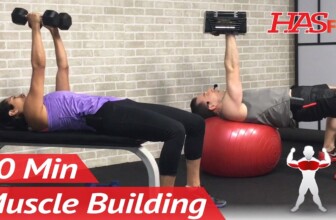Red Light Therapy Reduces Blood Glucose and Increases Metabolic Rate
Dr. Seheult from MedCram explains how red light therapy speeds up metabolism in the mitochondria, utilizing more glucose and making more energy. See all Dr. Seheult's videos at: https://www.medcram.com/
(This video was recorded on September 27th, 2023)
Roger Seheult, MD is the co-founder and lead professor at https://www.medcram.com/
He is Board Certified in Internal Medicine, Pulmonary Disease, Critical Care, and Sleep Medicine and an Associate Professor at the University of California, Riverside School of Medicine.
LINKS / REFERENCES:
Associations of Outdoor Temperature, Bright Sunlight, and Cardiometabolic Traits in Two European Population-Based Cohorts (Journal of clinical endocrinology and metabolism) | https://pubmed.ncbi.nlm.nih.gov/30759251/
Signatures of Mitochondrial Dysfunction and Impaired Fatty Acid Metabolism in Plasma of Patients with Post-Acute Sequelae of COVID-19 (Metabolites) | https://www.mdpi.com/2218-1989/12/11/1026
Optical stimulation of mitochondria reduces blood glucose levels (ResearchGate) | https://www.researchgate.net/publication/373466102_Optical_stimulation_of_mitochondria_reduces_blood_glucose_levels
Sunlight: Optimize Health and Immunity (MedCram) | https://youtu.be/5YV_iKnzDRg
Long Covid and Fat Metabolism Mitochondrial Dysfunction: Getting Outside Might Be an Answer (MedCram) | https://youtu.be/JGO2qb7wZns
Near Infrared Light (940nm) Improves COVID Outcomes: Exciting Randomized Control Trial (MedCram) | https://youtu.be/ZdiUnmpOgqE
SUBSCRIBE TO THE MEDCRAM YOUTUBE CHANNEL:
https://www.youtube.com/user/MEDCRAMvideos?Exposure to a more unhealthy diet impacts sleep microstructure during normal sleep and recovery sleep: A randomized trial=1
Get notified of new videos by hitting the bell icon
MEDCRAM WORKS WITH MEDICAL PROGRAMS AND HOSPITALS:
MedCram offers group discounts for students and medical programs, hospitals, and other institutions. Contact us at customers@medcram.com if you are interested.
MEDIA CONTACT:
Media Contact: customers@medcram.com
Media contact info: https://www.medcram.com/pages/media-contact?utm_source=Youtube&utm_medium=Video&utm_campaign=Video+Link+Clicks&utm_term=Insights+Into+Cirrhotic+Bleeding+of+the+Liver%2C+and+How+to+Stop+It&utm_content=CaBnPmyY5kE
Video Produced by Kyle Allred
Edited by Daphne Sprinkle of Sprinkle Media Consulting, LLC
FOLLOW US ON SOCIAL MEDIA:
https://www.facebook.com/MedCram
Tweets by MedCramVideos
https://www.instagram.com/medcram
DISCLAIMER:
MedCram medical videos are for medical education and exam preparation, and NOT intended to replace recommendations from your doctor.
#redlight #infrared #glucose
[Music] reducing your blood sugar and it has nothing to do with what you're eating or exercise this is Dr Roger scheld here for another mudram video if you are longtime listeners you will know that we have talked extensively about the ability of light to impact our metabolic Health we talked about this study before called associations of outdoor temperature bright sunlight and cardi metabolic traits in two European populationbased cohorts 13,000 people signed up for this study in both the Netherlands and in England and they found that if you had more sun in the previous 7 days before a blood test you had a better chance of having more insulin sensitivity and less diabetic profiles and we talked about this in our light as medicine video which I highly recommend we've gotten more comments and more emails saying that this video changed their life because in that video we talk about not only sleep but we also talk about daytime and being awake and getting outside and what effect that that has on things like the mitochondria and the Matrix and reactive oxygen species electron transport chain if you want a deep dive into the metabolic health of your cell and why light is important I highly recommend among other things watching light as medicine on our Channel put that together with our video on long coid from bad fat metabolism which showed that when you go from a healthy State here to a postco and even a long coid State notice here that there's generally a blue hue to these enzymes that are involved with fatty acid metabolism in the mitochondria to a red Hue here there's a huge distinction especially in our postacute SARS K2 patients that there is a definite slowing down of fatty acid metabolism that's exact actly what we think is going on today what I want to talk about though is not infrared light which we've been talking about before but actually just red light near infrared radiation you cannot see it's felt as heat warmth from the Sun but red light therapy you actually can see and there's a lot of lighting and products that you can buy that have red light and I want to show you here how this red light therapy in a very well-designed randomized control trial showed that this can reduce glucose levels especially when being challenged with a oral glucose tolerance test I want to remind you that we maintain medcram.com which is a continuing medical education website designed not only for healthcare providers but also lay people we do offer CME units and we cover everything from congestive heart failure to COPD to kidney failure we also talk about abgs EKGs chest x-rays and how to interpret those let's get to the study this has been published on Research Square titled Optical stimulation of mitochondria reduces blood glucose levels it's out of the uh University of London authored by Michael poer and Glenn Jeffrey and it is just been posted in the last month and it has not yet been peer-reviewed but before we get into the details of this we've got to review a little bit of the nomenclature and the definitions and things of that nature of cellular respiration what actually goes on in the mitochondria so bear with me as we talk about that briefly it'll make what we're about to cover a little bit more understandable so here you have the bane of existence of the biochemistry student it's basically the mitochondrian which is the basic organel of energy production in the cell and what is represented here is you've got glucose which is right here under go glycolysis or if you like glycolysis which breaks down that glucose into two three carbon units called pyruvic acid in that process you actually get some energy net energy out by direct synthesis substrate level phosphorilation and you get two atps ATP is the basic unit of energy in the cell but this pyruvic acid then goes into the mitochondria which are these organel in the middle of or in the cytool of the cell and acetic acid gets converted into and then enters as acetel COA into something called the citric acid cycle otherwise known as the kreb cycle otherwise known as the TCA cycle there's different names for it but basically What's Happening Here is you have the cycle going around and as a result you get another two atps but more importantly you get these very reduced electrons these electrons are high powerered and they are all shuttled in the form of nadh and fadh2 to something called the electron transport chain now here in the electron transport chain as those electrons start to go down a Cascade from high energy to low energy and being passed on finally to the lowest energy acceptor which is oxygen to make water protons are being pumped into this dark area called the inner membrane space and that causes the pH in that space to drop because there's a high concentration of protons these protons are then funneled through very specific filters this is kind of like the exit holes on a dam and as they go by they are turning the turbine but in this case instead of turning the turbine and creating electricity it's making ATP and it makes quite a lot of ATP as it turns out 32 atps per molecule so you can see here clearly if we're talking about energy that glycolysis or glycolysis and this substrate level phosphorilation is not making much energy the real energy that's being made is here in the mitochondria and specifically at the ATP synthes enzyme so anything that is going to speed this process up is going to create more ATP and it's going to utilize more glucose but notice that there is another end product to all of this cellular respiration and that is carbon dioxide what comes out of this process is carbon dioxide as this process accelerates you're going to have more ATP more carbon dioxide and less glucose as it's being used up and this whole process as it gets revved up is going to increase your basil metabolic rate weight which is important if you want to lose weight and you want to be healthy and you want to have enough energy to sustain your cellular resources so let's take a look here and see what the researchers knew prior to this test to see why they did this test and it's right here in their introduction this is the background to what they knew was going on before they conducted the study they say here red light and let me stop right there this red light part of this is in the visible spectrum some people would say up to 760 nanometers I guess it depends on the person but generally speaking most of this is visible red light not infrared light which is invisible they say here stimulates mitochondrial respiration and shifts the metabolism this photobiomodulation Alters cellular respiration rate increases membrane potential ATP production and subsequently reduces reactive oxygen species and inflammatory markers and they have references for that and of course we'll put the reference to this paper in the description below this results in improved sensory and motor function including aged human color perception 670 nanm which is the wavelength that we're talking about in this study and other longer wavelengths of red or near infrared are absorbed by the nanoscopic interfacial water layer surrounding mitochondrial ATP rotor pumps the energy transfer reduces water viscosity allowing the rotor pump to achieve greater momentum and increase ATP production let's take a look at that again let's go back they're saying that there's a rotor on this enzyme and near infrared and infrared radiation allows this water around here to become less viscous so this is able to spin faster and you're able to make more ATP they go on an increase in ATP production rate requires more fuel what we're seeing here is that as this starts to speed up it's going to speed up this whole process and that is going to reduce your glucose concentrations they go on and say glucose is the primary fuel source in animals and as shown previously systemic glucose concentrations decrease in an invertebrate model bees so these authors have also done previous research that showed exactly what we're going to show today in bees and this is the first time now that they're showing it in humans and they're ready to publish and the reason why they believe this is going to happen in humans is because they believe a lot of the enzymes that fuel the mitochondria in bees are preserved oberved and conserved in the enzymes that are in man's mitochondria finally what they say here is here we have extended these findings from invertebrates into humans demonstrating that nonpharmaceutical noninvasive Optical interventions can be used to support blood glucose level management let's take a look and see if they were able to do that they did a study and here they involve 30 subjects which is not a lot but if you're able to get statistical significance with 30 subjects and that shows that it's a pretty powerful effect and they randomize them that's important to know because randomized controlled trials don't involve bias they don't have confounders and it's one of the highest levels of evidence when you're looking at a study the first group is what we'll call the placebo group and the second group is the 670 group and that's simply referring to the nanometers that they're actually going to get 670 nanm so what happens to this group both of them have a glucose tolerance test that glucose tolerance test is basically 75 G of glucose in 150 mL of water and their blood glucose and carbon dioxide levels are measured so they're measuring exhale carbon dioxide and they're also getting plasma glucose concentration checks nothing is being done to them in both of these situations we're going to call this the no Placebo in the placebo group CU they know here that they're not getting any treatments they don't know which group they're in of course it's blinded but they're not getting any sort of treatment they're just coming in and getting a baseline test where they ingest a bunch of sugar and they see what happens to their blood glucose and what happens to their exhaled carbon dioxide same thing over here in the 670 group except here we're calling it The no 670 test in the 670 group cuz they're not getting anything done to them here so this is the control group for both less than 7 days later so it had to be less than 7 days later cuz we didn't want anything to change much with their metabolism they then in the placebo group get a placebo and another glucose tolerance test and here they get 670 nanm of light and get the glucose tolerance test let's talk a little bit about how they got this light they got this light for only 15 minutes and the power of that light was 40 m per square cm they got this light on their back over an 800 square cm area which is about a square foot and the light was 40 cm away from the subject it was given 45 minutes before the glucose tolerance test let's review it was given 45 minutes before the glucose tolerance test only for 15 minutes it was held 40 cm away from the patient and on the patient it radiated 800 square cm at a power of 40 m per square cm most of the red light fixtures or products that you can buy on the internet range Above This they're usually around 60 some of them go to as high as 100 or even more so this is not a very powerful light when they put this light on the back of the patient it was sealed off to their skin so that they could not tell whether or not the switch was on or off and that's how they were able to get the placebo so they would put the fixture on the back of the patient and so they could not tell the only difference between the placebo and the actual intervention group was someone turned the switch on versus someone turn the switch off and of course it was on their back so they couldn't see it let's see what the results were in terms of glucose and I've colorcoded these groups it'll make it a little bit easier we're going to look at blood glucose after the glucose tolerance test and we're going to compare the placebo to the actual intervention here on the next graph let's take a look at that so green is the placebo red is the intervention blood glucose and this is measured in milles per liter if you want to convert this into into Mig per deciliter remember that 1 Millo per liter is equal to 18 mg per deciliter this is what it was at the resting Baseline and this is how much it went up and you can see here clearly at around the 45 minute Mark and the 60-minute mark there was statistical significance actually in many of these places that those that were on the placebo had higher glucose concentrations than those that were irradiated 45 minutes before for this glucose tolerance test for only 15 minutes at 600 nanometers there was a statistically significant less blood glucose concentration now what we're going to do is compare these two groups here the intervention group with in the same group those that just had a regular glucose tolerance test without the light strap to their back the people in the intervention group that did not have this 670 NM light very statistically significantly different compared to same group of people when they did get it very different glucose concentrations so the next graph I want to look at is these two groups here to see if there's any difference between those we see here that there is no statistical significant difference between any of these groups here you can see that very clearly let's go ahead and now talk about the maximum glucose concentrations that we saw in those groups remember that this is the placebo group as the Baseline the this is the placebo this is the Baseline in the 670 group and of course the intervention and what we can see here is no statistical significant difference between in the placebo group no Placebo and Placebo but there is a statistically significant difference between in the 670 group when they got the 670 nanometers of light and when they did not get the 670 of light and of course there's statistical significance here as well which is the point of the study let's review here again when we radiate with red light that's visible what the study authors indicate is that there is an effect on the water around this pump that allows it to spin faster and it reduces the concentration of glucose and also at the same time increases the basil metabolic rate and there seems to be very good evidence to that could it be that the glucose is just going down because of some other mechanism if this is truly happening we should also see carbon dioxide levels go up so that's what we attempted to look at here let's see if that happens and so the first thing we're going to do here is look at carbon dioxide levels between these two groups there is an increase in some places and a decrease in others between the placebo and the 670 nanometer group and at no point here along the way was there any value that was statistically significantly different than the other but as I say often the absence of evidence does not equal evidence of absence so it could very well be in this study that it was underpowered and they couldn't get a statistical significance let's take a look at the difference between these two groups cuz it could very well be that randomization may not have been good but if we go and see a difference between these two groups that might mean something and that's in fact what we see here that n tial CO2 did go up with the glucose tolerance test but it went up statistically significantly more when they got the 670 and so what does that mean it means that the reduction in glucose must be due to at least in part an increase in the metabolic rate at that time with more consumption of glucose turning into ATP let's again look at these two groups and see if there's any difference we should not see a difference between those two groups and in fact we don't so it seems as though there is good evidence that frequencies of light that come from the Sun that are powerful enough to go in and through the skin and down into the tissue and to affect the mitochondria can in fact improve mitochondrial function and also metabolic Health we saw this already on a population level we saw this in populations where in the previous 7 days if we looked at the weather reports and we saw that there was more sunlight in those S days that on average those subjects getting the blood test had better metabolic Health than those with less and this shouldn't be a surprise we've also talked about this with this study this was a study that looked at near infrared radiation in Co 19 patients and I highly recommend that you go back and look at this because this is an amazing study looking at another randomized control trial showing that near infrared radiation from LEDs when placed on patients who had mild to moderate Co 19 improved and got better than those that did not and they got better in terms of their white blood cells pulmonary function tests in terms of their oxygenation and a number of Vari Ables this has been a journey for me if you look back at the co 19 videos that we did at the very beginning of the pandemic and even after that shortly I've started to research this looking at oxidative stress and it's become very clear to me because of what has happened in the different countries around the world what has happened to developed countries versus non-developed countries why we had for instance 4% of the population of the world but 25% of the co 19 cases while we have an epidemic of depression obesity it's because in part we're not getting outside enough we are stuck on devices computers and we're not getting outside and this is not a hypothesis we know that 93% of our lives are inside we get up in the morning go to our car in our garage we drive in air conditioned cars to work and work all day in offices that have low E glass that don't let near infrared light in under fluorescent bulbs or LED bulbs and then we drive home home and the sun is down turn on the television and watch that past 9:00 we wonder why we're plagued with such rates of obesity and things of that nature whereas in countries that are not as developed or technologically advanced where they're not on computers all day and they're going outside and they are doing practical things with themselves getting sunlight working exercising breathing fresh air these are the countries that actually had less Co 19 mortality have less obesity rates and what we were surmising at the population level with ecological studies we're now starting to confirm on the microbiological level and the biochemical level with studies in the laboratory and I don't want you to mistake the point in this the point here is not to go out and buy a red lamp although you can certainly do that especially if you're living at Northern latitudes and the sun is not out some times of the a the point here is that we need to get outside and take the benefit of the largest free near infrared and red lamp in the solar system thanks for joining [Music] us
#Red #Light #Therapy #Reduces #Blood #Glucose #Increases #Metabolic #Rate
source











I asked the study author to compare their intervention to sunlight. He stated that the device gives about 17mw/cm2 at 50cm and the sun is about 3mW/cm2 in the wavelength range so 5.5x more intense at that wavelength approximately. However, he also stated that he's seen the same switch at 2 min (just as good as 20 minutes). It seems to be like a switch that goes off with enough exposure and there is no dose-response curve meaning that more time or intensity doesn't mean a bigger drop in glucose. I've asked him for commercial product recommendations and I'll see what he says. For more information and continuing medical education on vital topics, such as EKG, and congestive heart failure to name a few go to medcram.com today.
A brilliant explanation of cell respiration and how we simply need to be outside more.
I wonder if sunscreen impacts results
Thanks❤
I’ve noticed when I do a dual 660/850nm red light session for 30 minutes (on a empty stomach in the morning after waking up and waiting around 30 minutes) that my blood glucose increases around 20-25ml/dl. From around 95-100 to 120-125. I was expecting the opposite effect after watching this video.
Need to start having red light parties in the winter.❤
This is great advice and all, but I have lupus and I can't stand sunlight. It makes me feel like my skin is burning up, and I am exhausted for hours afterward.
we as a species have been literally so fkn dumb for thinking that sitting inside (where windows block all useful light) would not interfere with our health lmaooo
I wonder how long the effect lasts . . . 1 hour? 24 hours?
I wonder if there’s any benefit to CGM type devices that deliver red light?
I wonder if there’s any benefit to CGM type devices that deliver red light?
Would be interested to see a study on people with type 2 and type 1 diabetes already diagnosed
Thank you
Thank you so much for this video!!
I am a 72 year old male with Long Covid and I am also prone to be hypoglycemic. I live in central Illinois where we are having lots of Spring rains etc and I have been using my infrared light more. Should I be careful of the amount of time I use the light? Thank You!
04:22 If red light therapy can lower blood glucose and boost metabolism, that’s a game changer. But the real question is: Are these effects significant and long-lasting, or just temporary like post-exercise changes? Has anyone tried it and seen real improvements in blood sugar or energy levels?
I take 5-10 mg (10-20 drops) of 1% methylene blue prior to pulsing RLT for the symbiotic benefits
Suggestion How about a study in a large insurance office with2 floors of workers seperated. No normal contact. One as is the other with incadesent lighting as it has a percentage of red light Less depression? Better etc
Where do I shine the Red Light …. what part of the body ?
Rose
The sun is very healing. It doesn't help that they are spraying our skies everyday and the sun is blocked from shining through. I do believe red light therapy could be very beneficial as well.
I can’t get enough of my red light panel from Future Form Official! My skin is looking great, and it’s super affordable.
I bought a lamp =(
Can red light improve blood pressure?
These are scam doctors.. i took red light therapy device believing him.. but it does not make any difference on blood sugar levels whatsoever.. please don't fall for it
Dr Roger Seheult the best U tube medical lecturer
Where did the energy go? Did they move more?
Of course it has nothing whatever to do with any changes in the way of life or behaviour.
THANKS FOR THOROUGH ANALYSIS🙏🏻
Great post. Quite a bit of 'science' but explained in a way a layman could understand.
Have any studies been done by this study author on ultraviolet or infrared lights effects on mitochondrial function or health benefits?
My Navy son will soon spend 9 months inside the air craft carrier. Surprisingly he was open to the gift of a near infrared lamp.
A friend is a type 2 diabetic, she tried red light therapy once for weight loss, she noticed a week later that she didn't need as much insulin. She regularly does red light therapy now and the amount on insulin she needs has gone from 18 to 24 units a day down to 4 units a day. Her doctor told her that her pancreas is now producing a small amount of insulin where it wasn't before.
I have bought a cheap led light and using it daily. I want to see whether it can improve my pancreas insulin production.
Ughhhhhh which commercial device to buy for the specific mitochondria help???
No sunlight after 5pm during witner in the northern US. Time for a red lamp.